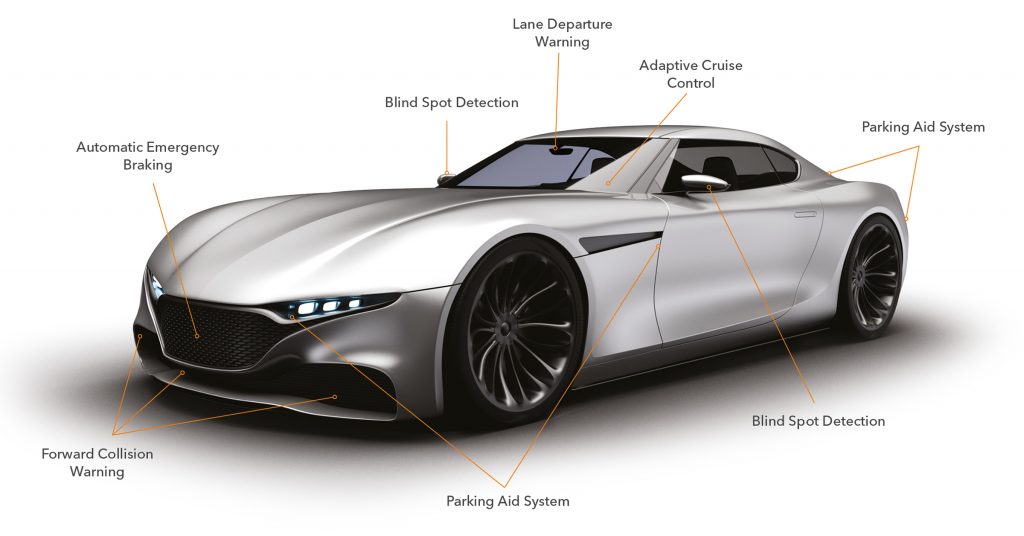Advanced Driver Assisted Systems (ADAS) includes technologies that help drivers with the safe operation of a vehicle, while providing information like vehicle status and changes in the driving environment outside the car. In some cases, it can assist drivers in controlling their vehicle by giving warnings and prompts that enable them to avoid dangers on the road, including traffic accidents.
ADAS mainly detects the environment through sensors and controllers. These elements transmit sensor data to the MCU for analysis as well as perform appropriate classification and processing. The MCU then outputs control signals to the actuators, which allow related devices to complete operations. ADAS helps to ensure the correct and safe movement of a vehicle while informing the driver of various hazards by taking effective corrective measures through accelerating, braking and steering assistance. ADAS has become an indispensable tool in automobile equipment and is an important component to realizing fully autonomous driving in the future.
The global self-driving technology classification is based on the standards of the American SAE (Society of Automotive Engineers) and is divided into levels ranging from 0 to 5. Level 3 is a dividing line where partial self-driving can be achieved, but drivers still need to stay focused while driving. The detailed classification is as follows:
| Level 0 | Level 1 | Level 2 | Level 3 | Level 4 | Level 5 |
|---|---|---|---|---|---|
| No automation | Assisted driving | Partial automation | Conditional automation | High automation | Full automation |
| The car is fully operated by the driver and only provides warning functions. | The car is operated by the driver and has basic assistance functions. | The car can be operated by itself under certain circumstances, but is mainly operated by the driver. | The car is fully autonomous. It can detect the environment and make decisions, but the driver still needs to be alert while driving. | In certain areas, the car can be fully autonomous. The driver doesn’t need to intervene when the autonomous driving function is activated. | The car is fully autonomous and there is no need for a driver. |
There are four main types of ADAS sensors typically used in automobiles:
The following is a comparison of these sensor technologies:
| Sensor Type | Camera | mmWave Radar | LiDAR | Ultrasonic |
|---|---|---|---|---|
| Range | 1-200 m | 100-200 m | 100-200 m | 1 m |
| Angle measurement | 30º | 10 – 6º | 20 – 360º | 120º |
| Road sign recognition | Good | Poor | Poor | Poor |
| Advantage | Highly sensitive | Strong penetrating power, not affected by weather | Large detection range with good accuracy | Simple structure |
| Disadvantage | Impacted by strong lighting | Less accurate | Rainy days have a big impact | Short detection range, not suitable for high-speed travel |
Lane Departure Warning System (LDWS): If a driver becomes distracted and causes the vehicle to deviate from the lane, the image sensor in this system identifies when the wheels are pressing on the lane line and alerts the driver with some type of a warning. Some vehicles are equipped with lane keeping assist, which is a more advanced version. If the system detects a potential lane departure and the driver does not respond, lane keeping assist will gently steer you back into the lane.
Parking Aid System (PAS): An active PAS automatically controls the steering wheel to assist the driver in parking maneuvers. A passive PAS uses ultrasonic waves to provide images of what is behind the vehicle and sounds alarms to help the driver complete a safe parking action.
Adaptive Cruise Control System (ACC): Through a front radar element, the system detects cars moving ahead of it and actively adjusts the vehicle’s speed to always keep a safe distance.
Blind Spot Detection System (BSD): When there is an object in the blind area of vision, the system will alert the driver using a light or audible alarm.
Forward Collision Warning (FCW): The radar sensor installed in the front of the vehicle continuously scans the road conditions ahead of it to determine the possibility of a collision based on driving circumstances. The system issues a warning sound to remind the driver to pay attention to the distance between vehicles.
Automatic Emergency Braking (AEB): This detects obstacles on the road ahead and provides a timely warning to the driver. AEB can directly intervene in braking when necessary to reduce the risk of driving when the driver is distracted.
Aker crystals meet the specific requirements for many camera and mmWave radar sensors in the following applications:


